Price reductions at Crocus
by Sarah - August 9th, 2009.Filed under: Crocus, Price Reductions.
Reduced products at Crocus
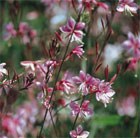
gaura was £5.49 now £3.99
Position: full sunSoil: fertile, well-drained soilRate of growth: average to fast-growing Flowering period: May to SeptemberHardiness: fully hardyA graceful, hazy plant with airy spikes of bright pink, star-shaped flowers with long anthers like daddy long-legs, held high above the foliage on slender stems from May to September. This long-flowering perennial looks equally at home in an informal cottage-style garden or among soft grasses in a new perennial border. It is exceptionally drought-tolerant and will soak up the sun. Give it space, as its wispy stems will lean over.Garden care: Resist the temptation to cut back gaura after it has flowered as it takes on beautiful autumn tints, particularly in cold weather. Lift and divide large colonies in spring.
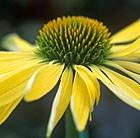
coneflower was £6.99 now £4.99
Position: full sunSoil: most soils, except vey dry or boggyRate of growth: average Flowering period: June to SeptemberHardiness: fully hardyHuge, yellow, daisy-like flower with reflexed petals and greenish centres appear from June to August. The scented flowers are a massive 12cm (5in) across and fade to a pale apricot. It is a tough plant that does not need staking and it makes an excellent cut flower. Like other coneflowers, it is long-flowering and will cope well with adverse weather conditions, except drought. Try it dotted through a sunny, mixed border, in bold drifts among grasses or as part of a 'hot' colour scheme. It is attractive to bees and butterflies, and birds will flock to the seedheads.Garden care: Lift and divide congested colonies in autumn or spring. In autumn cut back all dead flower stems to the ground. Coneflowers benefit from a spring or autumn mulch with well-rotted compost.
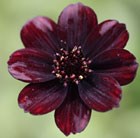
chocolate cosmos was £6.99 now £4.99
Position: full sunSoil: moderately fertile, moist, well-drained soilRate of growth: average Flowering Flowering period: June to SeptemberHardiness: half hardyA beautiful perennial, with sumptuous, velvety, bronze flowers produced above lance-shaped, blue-green foliage from June to September. The aroma of this new variety is even more chocolatey than Cosmos atrosanguineus and it's more compact too, so may not need staking. Great for growing in a sunny border and looks lovely when planted with other hot colours. To minimise frost damage, protect the tuberous roots with a cloche or overwinter in a frost-free environment.Garden care: In autumn after the foliage has died back reduce the stems to within 5cm (2in) of the roots. Lay in a tray of soil or compost and over-winter in a frost-free environment until early spring.
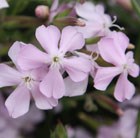
soapwort was £6.49 now £4.99
Position: full sunSoil: moderately fertile, well-drained, neutral to slightly alkaline soilRate of growth: average Flowering period: June to August Flower colour: soft-pinkOther features: narrow, grey-green leavesHardiness: fully hardy (borderline)A tumbling mass of soft pink, five-petalled flowers on hairy stems from June to August. This low-growing, evergreen perennial is perfect for the front of a sunny, well-drained border, rock garden or raised bed. Since it actually prefers neutral to slightly alkaline soil it's a good choice for a site recently cleared of builders' rubble.Garden care: Lift and divide congested colonies in autumn or spring.
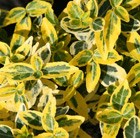
evergreen bittersweet was £5.99 now £4.99
Position: full sun or partial shadeSoil: any well-drained soilRate of growth: fast-growingFlowering period: May and JuneHardiness: fully hardyClusters of insignificant, green flowers appear in May and June among small, lustrous, green leaves with yellow margins. This popular, bushy, variegated, evergreen shrub makes excellent groundcover and is a mainstay of low-maintenance gardens, but it also makes a good foil for more ornamental, golden-leaved shrubs. It is tough and will thrive in any well-drained border in sun or partial shade.Garden care: Tip prune young plants in mid to late spring to encourage bushy growth and apply a generous 5-7cm (2-3in) mulch of well-rotted garden compost or manure around the base of the plant. Remove any plain green-leaved shoots as soon as they appear, cutting them back to the original branch.

chrysanthemum was £5.99 now £4.99
Position: full sun Soil: well-drained soil Rate of growth: fast Flowering period: July – October Flower colour: Apricot Other features: make good cut flowers Hardiness: fully hardy but protect from excessive winter wetChrysanthemums were prized by Gertrude Jekyll for their fresh colour contribution to the autumn scene. This trouble-free selected form is easy to grow, producing twiggy, branched stems which support large sprays of open single daisies in a warm apricot pink. Capable of reviving a flagging planting later in the season, they associate well with Asters and Sedums of the same period and are a good contrast to vertical grasses. An excellent cut flower for the harvest festival!Garden care: Insert twiggy prunings early in the season to provide invisible and effective support.Apply a thick 5-7cm (2-3in) mulch around the base of the plant in Spring, taking care not to cover the crown.
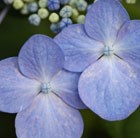
lacecap hydrangea (syn. Blue Wave) was £7.99 now £5.99
Position: full sun or partial shadeSoil: moist, well-drained, moderately fertile, humus-rich soilRate of growth: average Flowering period: July and AugustHardiness: fully hardyOne of the most popular lacecap hydrangeas, this has flattened heads of rich blue, mauve or lilac-blue flowers in acidic or neutral soils, or pink flowers in alkaline soils. These appear from July to August over coarsely toothed, glossy, dark green leaves. It's best in moist soil in partial shade and looks wonderful towards the back of a mixed or shrub border, particularly when planted with other hydrangeas. Hydrangeas give their best blue flowers on acidic soils with a pH 5.5. When grown on neutral soil, (with a pH of 7), the flowers will predominantly be pink, although you may also get blue or mauve blooms. If you want to make sure that your Hydrangea has blue-toned flowers, you will need to make sure your pH does not creep above 6.5. To lower the pH on a neutral soil, you can treat it annually with aluminium salts. It's much harder however to alter the pH of limey (alkaline) soil, so it's much easier to grow white or pink hydrangeas instead.Garden care: Hydrangeas do not like to dry out. In dry weather, soak the roots with a hose and the plant will usually recover. Remove faded flowerheads in spring after the danger of frosts, cutting back the flowered stems to a strong pair of buds. Take out misplaced or diseased shoots. Mulch young plants with a well-rotted manure or compost in spring. Once established, remove a quarter to a third of the shoots to the base of the plant.
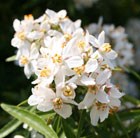
Mexican orange blossom was £8.99 now £6.99
Position: full sun or partial shadeSoil: fertile, well-drained soilRate of growth: fast-growingFlowering Period: May, but they often have a second flush in late summer or autumnHardiness: fully hardyAn evergreen shrub with slender, glossy, dark green leaves, and clusters of fragrant, pink-tinged white flowers in late spring, 'Aztec Pearl' is a more compact alternative to the ubiquitous Choisya ternata. It's ideal for the back or middle of a mixed border, and in hot summers, and in full sun, may flower twice without pruning. It can also be grown in partial shade as an attractive foliage plant. Although it's fully hardy, the leaves may be damaged by exposure to strong winds or frost.Garden care:Prune established plants in spring immediately after flowering, removing 25-30cm (10-12in) of the flowered stems. This encourages a second flush of flowers in late-summer and autumn. At the same time, remove any frost-damaged stems to the base.

Chinese plumbago was £7.49 now £6.99
Position: full sunSoil: fertile, light, moist but well-drained soilRate of growth: fast-growing Flowering period: August to OctoberHardiness: fully hardyThis spreading, deciduous shrub brings welcome colour to the garden in late summer and early autumn when many other flowers have gone over. Masses of disc-shaped, vivid cobalt-blue flowers appear from August to October, and in autumn, the leaves turn a rich russet-red. It's best in towards the front of a sheltered, sunny border in soil that does not get too dry.Garden care: In early or mid-spring cut back the flowered shoots to within 2.5cm (1in) of the old growth. After pruning apply a generous 5-7cm mulch of well-rotted garden compost or manure around the base of the plant.






